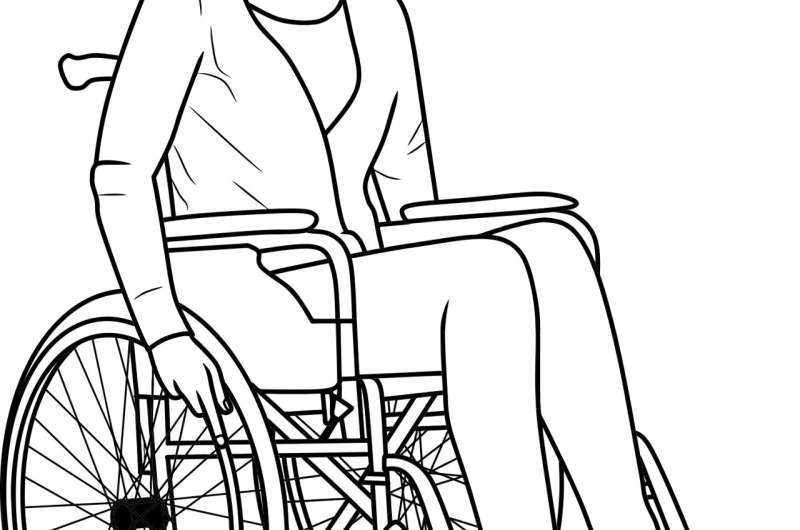This article has been reviewed according to Science X's editorial process and policies. Editors have highlighted the following attributes while ensuring the content's credibility:
fact-checked
trusted source
proofread
Making mammography inclusive for patients with disabilities

Lene Andersen, MSW, has been living with rheumatoid arthritis and disability since childhood. Her personal experience with limited mobility and the challenges faced in accessing mammography screening in Toronto, Ontario, has fueled her determination to advocate for change. Her story is featured in an upcoming themed issue of the Journal of Medical Imaging and Radiation Sciences on the topic of specialized populations.
In this personal narrative, Andersen, an advocate and accessibility consultant, teamed up with Natasha Batchelor, MHSc, MRT(R), a medical imaging technologist from the York region in Ontario with expertise in creating an accessible mammography environment. Together, they have published a call to action for a national response to remove barriers in breast cancer screening. Blending personal and professional knowledge, they offer valuable insights into creating an inclusive environment and practice.
In this narrative, Andersen outlines her experience as a wheelchair user with limited mobility in her arms and shoulders, which has created significant challenges in accessing mammography screenings. Despite having a lump in her breast for several decades, she was unable to undergo mammograms due to the lack of accessible equipment and procedures. She also highlights the challenges encountered as a wheelchair user with limited mobility, from contorting her body into uncomfortable positions for ultrasounds to the absence of fragrance-free gel triggering severe asthma attacks.
Reflecting on her journey, Andersen emphasized, "Discovering that I was not considered or deliberately excluded from the breast cancer prevention system was a shock that still reverberates in my life. It woke me up to the many ways in which health care fails to meet the needs and protect the lives of disabled patients."
She further noted that "…lacking recent studies, documentation, and accessibility guides, mammography clinics are left without guidance and standards to remove barriers and make this essential screening test inclusive for people of all abilities. This results in a patchwork approach to accessibility, one that relies on the awareness of each clinic and its staff to identify a lack of equity, as well as a guesswork approach to accessibility with a resulting potential for inadequate resolution and barrier removal. It is reasonable to expect that this has a direct impact on early detection and survival rates in disabled patients."
Batchelor, a mammography and breast imaging navigator/supervisor, has dedicated her career to improving the imaging experience for patients with disabilities. She has firsthand knowledge of the challenges faced by these individuals and has developed strategies and resources to address their unique needs. Batchelor's commitment to creating an inclusive environment for patients with disabilities has led to the creation of a webinar and resource materials, providing valuable training for fellow technologists and health care professionals.
Together, the authors outline a three-pronged approach to tackle physical, social, and procedural barriers. The article outlines numerous common physical barriers such as standing-person only check-in counters, small mammography rooms with no room for mobility aids, or forms requiring handwriting. Essential considerations to remove physical barriers include accessibility features such as adjustable equipment, accessible changerooms, and fragrance-free policies.
To address social barriers, such as bias, attitudes, and behaviors of health professionals, they stress the need for comprehensive training and resources. Procedural barriers refer to intake/admissions procedures and appointment accommodations, and the authors outline recommendations to improve these processes. By implementing the measures proposed in this call to action, health care systems can ensure that patients with disabilities have equal access to essential breast cancer screening services.
The authors underscore the need for meaningful consultations with disabled individuals ("nothing about us without us") and the involvement of accessibility professionals in the analysis of existing barriers and the development of solutions. While recognizing the financial constraints faced by some areas, they urge professional associations and clinics to unite in advocating for funding to remove structural barriers.
Simultaneously, they emphasize that immediate actions, such as awareness campaigns, accessibility training, and equipment adjustments, can be taken by clinics and technologists to improve accessibility and accommodate disabled patients.
Creating an inclusive environment for patients with disabilities requires collaboration among governments, health care systems, imaging associations, and individual clinics. The authors stress the importance of an equity-based and patient-centered approach to health care, urging stakeholders to prioritize the needs and experiences of disabled individuals. By addressing the identified barriers and implementing the recommended considerations, health systems can work towards eliminating inequities in breast cancer screening and ensure health equity for people with disabilities.
More information: Lene Andersen et al, Making mammography inclusive for patients with disabilities, Journal of Medical Imaging and Radiation Sciences (2023). DOI: 10.1016/j.jmir.2023.08.003





















